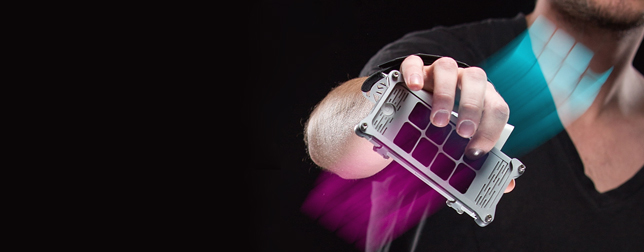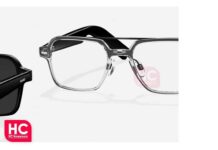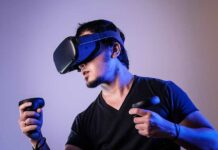Wearable musical instruments will probably not replace traditional ones. Doubting that many of these ideas will hit the mainstream these concepts anyhow offer a nice and very contemporary way to express yourself and allow you to make music anytime anywhere.
Currently the most common approach is using motion sensors. Accelerometers and gesture monitoring technologies not only revolutionized fitness, gaming, and safety devices but can also transform your body or parts of it into a musical instrument. Playing your instrument can even become a complete body workout.
Sound on Intuition by designer Pieter-Jan Pieters includes several technologies and transforms your body into a whole orchestra. Pieters created five “instruments”: “Wob” measures the position of the musician’s hand and changes the pitch of the note with the hand’s motion. “Finger” is a collar wrapped around the finger which converts tapping, bending, and stretching movements into sound. The heart rate monitor “heart” produces rhythms based on the beating of the musician’s heart, “kick” produces the sound of a bass drum according to the wearers’s foot-tapping, and “scan” reads lines or dots drawn to make sounds.
SOUND ON INTUITION from owow on Vimeo.
Still a concept without prototype based on the motion technology from Leap and Myo is Soundbrace by Eugene Wang. The idea is to transform your fingers and hands into a guitar. Two bracelets worn by the “guitar hero” measure the relative distance from each other and calculate the chords intended to play. The wristbands can be calibrated with a real guitar to determine the baseline measurements of chords and personal playing style. Accurate motion capture cameras detect finger positions, and gesture detectors measure the electrical activity of your arms’ muscles and translate it into sound.
AUUG is also based on motion technology but does not intend mimicking a specific instrument. Touch screen and motion sensing capabilities allow you to create music with an iPhone and iPod touch, to control a vocal harmonizer, laptop software, and hardware synth. After installing the app and slipping the iOS device into the grip the device is ready to play. Notes can be played on the touch screen and by moving the phone, the sound can be altered. You can configure how your movements create sounds. Shipping will start in May 2014 at a price of $99.
Motion Synth for iPhone and iPod touch from AUUG on Vimeo.
Machina’s MIDI Controller Jacket can be worn like a normal jacket but includes several hidden sensors. It serves as an interface for communicating with digital music instruments, computers, tablets, and other devices. The jacket can be controlled kinetically and via body sensors to make music. The functions can be adapted to individual requirements. The standard version comes with four flexible sensors to detect your finger’s position, accelerometers to detect the arms’ acceleration, a joystick, and four push buttons. The product is available for pre-order and will cost $480.
More artistic is the Instrumented Bodies project by the Input Devices and Music Interaction Lab at McGill University which works with prostheses to create sounds based on the movement of the wearer’s body. Singer and songwriter Imogen Heap wore musical gloves for a performance in 2012. Her motions guide computer-based digital creations; sound can be recorded, synthesized, manipulated by certain movements and gestures.
Integrating drums into pants seems to be rather obvious (e.g. Aseem Mishra: Drum Kit Jeans Drum’n Pants, Ubiquitous Drum Pants). Tyler Freeman worked six years on his project. In May 2014, the idea will finally become a product available for everyone. The DrumPants kit is a fully customizable on-the-go musical instrument with 100 built-in sounds (drums, percussion, synthesizers, guitars, pianos…) and compatible with all apps accepting MIDI and OSC. It works with Apple as well as Android. The ultra-thin velcro stickies can be attached to any clothing and are therefore not only restricted to your pants. Besides that the sensors can also be used to a control slideshow or silence your phone remotely. The product will be available from $99.
With brainwave technology we maybe will not even have to move a finger to create music. The results are still, well… something to get used to, but might deliver more promising results in the coming years.
Emotiv Insight is a wireless headset which can record your brainwaves and translate them to meaningful and understandable data. One possible feature is creating and mixing songs by measuring and tracking diverse facial expressions, affections, and conscious thoughts. The Smirnoff Mindtunes Project (with Emotiv EPOC, the predecessor model of the Insight) with three disabled musicians shows how this could look like – as well as the MiND ensemble which uses the device for their performances since 2010.
Artist Lisa Park also used an EEG headset (MindWave by Neurosky) for her performance “Eunoia” controlling the music with her consciousness and triggering loudspeakers assigned to a specific emotion. For “Le Violon d’Lisa” she uses a Nichrome wire attached to a cello bow which is programmed to create sound when it touches the performer’s body. Her performance “Obsession is sad Passion” is based on a heart rate sensor (Polar wear link and transmitter) which fosters that the pitch of the sound goes down and speed slows down when her heart rate goes faster.
Eunoia from Lisa Park on Vimeo.
The following products and concepts are not really “instruments” but can be used to increase the interaction between artist and audience.
A new startup called Lightwave just launched an interesting project for providing analytics around live events. The core of the project is a wristband that measures a number of different user interactions like movement, audio levels, and temperature to provide live performers with real-time data about their audience. Another approach is the Alert Shirt by Wearable Experiments which could allow fans to experience the physical sensations their star goes through during a concert (actually developed for fans watching football games) – or by wearing Google Glass the audience could see a concert through the artist’s eyes (e.g. Bon Jovi, 2013).
These are just a few ideas and projects in the field of music. Many more are being developed out there and certainly there is more to come.
















